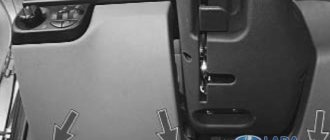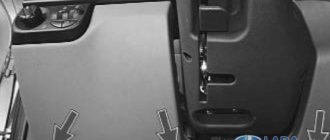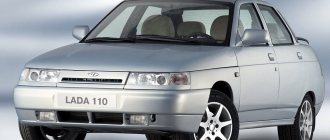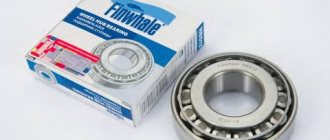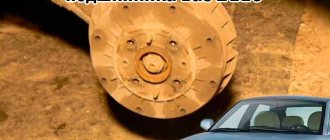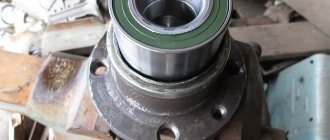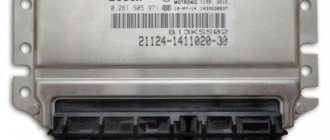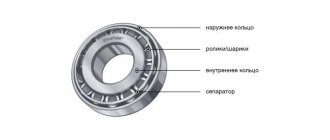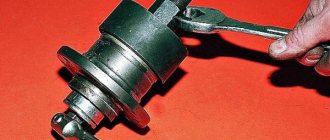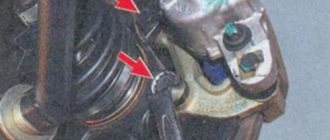If, while operating the vehicle, problems with the chassis are identified, this is a reason to take urgent measures to eliminate the problem. A suspension failure can lead to unpredictable consequences, including an accident. In this sense, the front hub is a very important component in a car that requires special attention.
Disassembly
Required : engage first gear and place shoes under the wheels. Prepare a narrow chisel, a 30mm socket, pliers, a needle file and a standard set of tools. The wheel bearing can be replaced on a level surface, but it is more convenient to do so on an inspection ditch or a lift.
Procedure:
- Remove the hub cap.
- Straighten the dented shoulder of the wheel bearing nut in two places using a narrow chisel.
- Loosen the hub bearing nut using a 30mm socket. The head and driver must be strong enough to transmit the required force.
| If while driving you notice that there is something humming in the front suspension, then most likely the problem is in the front wheel hub, in the bearing. You can replace the front wheel bearing yourself, but this will require some experience. |
Loosen the wheel mounting bolts, and then hang both front wheels, otherwise the anti-roll bar will interfere with dismantling, pushing the suspension elements up. Remove the wheel, the brake pad guide together with the caliper and the brake disc (tie them so that they do not hang on the brake hose).
What tools do you need to prepare for work?
First of all, you should make good lighting in the garage, since the size of the front wheel bearing of the VAZ-2110 is small, and in order for the replacement of the faulty component to be carried out correctly and effectively, the car owner must see all the parts clearly.
It is best to place the car in a special pit for inspection and repair so that the operation goes faster and the work is more convenient. It is worth noting that replacing the rear wheel bearing is much easier than replacing the front one. But still, by following the recommendations and carrying out the repairs step by step, you can do all the work with your own hands, as they say, “perfectly.”
The following tools are prepared for it:
- Automotive puller for easy removal of an unusable bearing related to the front hub.
- A pre-prepared piece of durable metal pipe called a “mandrel.” It will be needed to knock out the hub in the car.
- Automotive head equipped with a 30-mm wrench.
- Socket wrenches for 19 and 17.
- New high quality bearings.
According to experienced specialists, replacing a bearing related to the front hub area for a VAZ-2110 vehicle will be of high quality if the car owner purchases a new part made by Russian manufacturers. The price of Russian material is not much different from its Chinese counterpart, so you should not try to save a few rubles and end up purchasing an unreliable component.
Failures in the chassis of the car, design and fastening of the hub
Experienced motorists can easily diagnose problems with the car's chassis. These include:
- body swaying when turning or braking;
- uneven abrasion of the tire surface;
- easy compression of shock absorbers or leakage;
- constant deviation of the car to the side from straight-line movement;
- increased vibration;
- extraneous sounds when driving.
The causes of these phenomena are most often unacceptable wear of suspension parts, poor mounting of shock absorbers, and incorrect wheel alignment. Broken joints and deformation of at least one lever can also cause trouble. The front wheel hub of the VAZ 2110 is most susceptible to failure in front-wheel drive cars, to which this model belongs.
Most cars with front-wheel drive have independent telescopic front suspension and hydraulic shock absorbers with springs. Stabilizers are located on the lower wishbones. The hub itself is attached to the lower arm through a ball joint with a nut and to the shock absorber with bolts. It communicates with the steering rod through the steering knuckle.
The part is cast from durable steel, and inside it there is a bearing, which is the most vulnerable element. Its failure is indicated by extraneous noise when moving. The brake disc and brake caliper with pads are also attached to the hub. Unlike the rear hub, the front hub is more complex, so repairing it requires more care and skill.
Installation procedure for a new VAZ 2110 hub
When replacing the front wheel hub of a VAZ 2110, the product is cleaned of grease and dirt with sandpaper, and burrs are sanded off. Installation process:
- First, a thin layer of lubricant is applied to the rear of the hub O-ring and the hub is installed onto the steering knuckle axle.
- A thrust washer is installed and a nut is screwed on to secure the hub.
- The hub fixing nut is tightened and the inner ring of the bearing is pressed onto the steering knuckle axle.
- Once the hub is installed, the hub bearing end play is adjusted .
- After the adjustment is completed, the clamping bolt is tightened, which secures the fastening nut from unscrewing.
- Then the brake disc is installed and, if equipped with anti-lock braking system, the sensor is installed.
The following is a step-by-step photo instruction on how to independently replace the front hub on a VAZ 2110.
1.6.3 Fastener dimensions
Fastener dimensions
For many reasons, vehicle manufacturers are using metric fasteners more and more widely. However, it is important to know the difference between the sometimes used standard (also called American, or SAE standard) and the more universal metric fasteners in the system of measures, since, despite the external similarity, they are not interchangeable.
All bolts, both standard and metric, are classified by diameter, thread pitch and length. For example, a standard 1/2 - 13 x 1 bolt is one-half inch in diameter, 13 threads per inch, and 1 inch long. A metric bolt M12 - 1.75 x 25 has a diameter of 12 mm, a thread pitch of 1.75 mm (the distance between adjacent turns) and a length of 25 mm. Both bolts are almost identical in appearance, but are not interchangeable.
In addition to the characteristics listed, both metric and standard bolts can be identified by inspection of the head. For starters, the distance between the flats of a metric bolt head is measured in mm, while that of a standard bolt is measured in inches (the same is true for nuts). As a result, a standard wrench is not suitable for use with metric fasteners, and vice versa. In addition, the heads of most standard bolts usually have radial notches that determine the maximum permissible tightening force of the bolt (strength rating). The greater the number of notches, the higher the permissible force (on cars, bolts with a strength rating of 0 to 5 are usually used). The strength class of metric bolts is determined by a numerical code. The code numbers are usually cast, as for standard ones, on the head of the bolt (on cars, bolts of strength classes 8.8, 9.8, and 10.9 are usually used).
| Marking of bolt strength class (top - standard/SAE/SS, bottom - metric). |
Also, standard nuts can be distinguished from metric ones by strength class marks. To identify the strength of standard nuts, dot marks are used that are stamped on one of the end surfaces of the nut, while metric nuts are marked using numbers, again. The greater the number of points, or the higher the digital code value, the higher the permissible tightening force of the nut.
The ends of metric studs are also marked according to their strength class. Large studs are marked with a digital code, while smaller ones are marked in the form of a geometric figure.
It should be noted that a significant part of the fasteners, especially those with strength classes from 0 to 2, are not marked at all. In this case, the only way to distinguish a standard fastener from a metric one is to measure the thread pitch, or compare the thread with a uniquely identified one.
Standard fasteners are often also called, in contrast to metric, SAE standard fasteners, however, it should be remembered that only small fasteners fall under the SAE classification. Large fasteners with non-metric threads are American Standard (USS) fasteners.
Since fasteners of the same geometric size (both standard and metric) can have different strength classes, when replacing bolts, nuts and studs on a vehicle, attention should be paid to whether the strength class of the new fastener being installed matches the strength class of the old one.
Strength class markings for standard hex nuts
| Strength class | Class Identification |
| Hex nut - strength class 5 | |
| Hex nut - strength class 8 |
Strength class markings for metric hex nuts
| Strength class | Class Identification |
| Hex nut - strength class 9 | |
| Hex nut - strength class 10 |
Marking of strength class of metric studs
Standard (SAE and USS) bolt dimensions/markings
| G - Strength Marking L - Length (in inches) T - Thread Pitch (threads per inch) D - Nominal Diameter (in inches) |
Dimensions/markings of strength class of metric bolts
| P - Strength class L - Length (in mm) T - Thread pitch (distance between adjacent threads in mm) D - Nominal diameter (in mm) |
Metric thread sizes
| M-6 | 9 - 12 N•m |
| M-8 | 19 - 28 N•m |
| M-10 | 38 - 54 N•m |
| M-12 | 68 - 96 N•m |
| M-14 | 109 - 154 N•m |
Pipe thread sizes
| 1/8 | 7 - 10 N•m |
| 1/4 | 17 - 24 N•m |
| 3/8 | 30 - 44 N•m |
| 1/2 | 34 - 47 N•m |
American Standard Thread Sizes
| 1/4 — 20 | 9 - 12 N•m |
| 5/16 — 18 | 17 - 24 N•m |
| 5/16 — 24 | 19 - 27 N•m |
| 3/8 — 16 | 30 - 43 N•m |
| 3/8 — 24 | 37 - 51 N•m |
| 7/16 — 24 | 55 - 74 N•m |
| 7/16 — 20 | 55 - 81 N•m |
| 1/2 — 13 | 75 - 108 N•m |
Symptoms of malfunction
Replacing the VAZ 2110 wheel bearing is necessary when the following symptoms appear:
- The rolling round elements gradually destroy the clip. After this, their arrangement becomes disordered. This is accompanied by a strong crunch, which is clearly audible in the cabin.
- After a long run of the car, gaps form between the bearing parts. This manifests itself in the form of vibration. It extends to the steering column and body.
- The car begins to pull to the side. This also happens when the elements are faulty.
Troubleshooting
Driving with a faulty bearing is extremely dangerous. This is due to the fact that this element can jam at any time. As a result, the car is at risk of getting into an accident. To prevent this from happening, you need to check regularly.
It is carried out in the following order:
- A flat area is found for the car.
- The simplest check is possible without lifting the wheel. To do this, swing it with your hands at the highest point. The hub play is clearly audible.
- For greater confidence, the wheel is hung on a jack and rotated by hand. The malfunction manifests itself in an audible crunching sound.
- If possible, you can hang the front wheels, start the engine and engage the gear. As the wheels rotate, noise can be heard. Whichever side it goes from, that’s where the breakdown is present.
Features of tightening the hub nut
Not understanding how hard to tighten the wheel nuts
It's better not to take this job. If you overtighten them, a breakdown will occur, and if you don’t tighten them, then spinning may occur and the seat under the bearing will deteriorate. Anyone who is not confident in their knowledge can use a spring cantor, but you can do it in a simpler way. Ratchet drivers most often cannot provide sufficient force, and the tools designed for this are expensive.
To prevent damage and perform the job correctly, for broaching
It is recommended to use a lever that is a meter or a little longer. If a fine thread pitch on a car hub may require a force of 20 Nm, plus it will be necessary to turn the key another 90°, in total such efforts will give a very decent tightening torque. Anyone who remembers physics can make a simple calculation. To do this, you need to know your weight and the length of the lever. A value of 20 Nm is equal to a force of two kilograms with a lever length of a meter.
Force, then with what torque to tighten the hub nut
, depends on the individual characteristics of the vehicle. Torque recommendations for even the same bearing often vary. They depend on the quality of the metal of the hubs, the strength of the nuts, axles, and threads. Usually 19-23 kgf/m is enough. If the bearing weakens and the gap reaches 0.06-0.08 millimeters, this will significantly affect the reduction in the service life of the entire mechanism.
Experts who have worked in car repair shops for many years recommend tightening the hub nuts every 15-20 thousand kilometers. In this case, it will be useful to loosen them a little by one or two turns. It is best to have the car raised with a jack. To carry out this process, many advise using a tubular spanner, because it has thick walls and there is room for a wrench, and it is more powerful. Thanks to a special adapter, you can use a pipe.
Modern cars are equipped with crimp nuts that do not need to be locked. They have belts and they will press themselves into the grooves of the axle. You don’t need to put all your hundred kilogram weight on the key; it’s actually twice as hard as necessary. Knowing exactly what torque to tighten the hub nut
you can avoid losing a wheel on the way, before this a knock will occur when turning, and the car may fly into a ditch.
A tightly stuck nut is a common problem. It is often encountered by motorists, plumbers, cyclists and mechanics. It always takes a lot of effort and time to unscrew a rusty nut.
There are several ways to make this difficult task easier. But before you apply various tricks, familiarize yourself with the reasons that lead to soured nuts and safety precautions.
Replacement features
The front hub of the VAZ 2107 car has a pair of roller bearings, one of which is called internal, and the second external. The manufacturer recommends replacing these products in pairs, on both front wheels of the car. We will find out further what the replacement of the parts in question is.
Algorithm for replacing a faulty bearing
The work is performed in almost the same sequence. As for many other VAZ models (classics):
The vehicle is fixed;
Hanging out;
The wheel is dismantled;
The caliper is removed (it is possible without disconnecting the brake hoses);
Use a bayonet screwdriver to pry up the protective cap that covers the hub nut, remove it;
Unscrew this nut, remove the separator and washer, dismantle the hub along with the brake disc;
Remove the oil seal;
Remove the separator;
Remove the ring placed between the outer and inner bearings;
Using a suitable size drift and hammer, knock out the clips.
Now you can proceed to installing a new bearing and assembling the hub. The operations are performed in reverse order.
Before starting assembly, it is imperative to remove dirt and old lubricant residues and wash the parts (using special cleaning fluids).
The outer races are removed from the new bearings in a vice. Internal ones, using special spacers (for example, an old clip), are pressed into place.
Installing new bearings
The inner bearing cage is lubricated and installed in place. Then, the spacer ring. Next, the oil seal is pressed in (be careful not to damage it during installation).
Apply lubricant
The brake disc is put on and secured with studs.
The assembled unit is put in place. Then the separator of the second bearing (external) is lubricated and installed, the washer is inserted, and the nut is tightened until it stops.
Read it, it may come in handy: Adjusting and repairing the clutch
The wheel is put on and the nut is unscrewed until slight play occurs. Then it is locked in this position.
We put new grease into the previously cleaned cap and put it in its original place.
Which way does the hub nut unscrew?
Yes, you may very well be one of the lucky ones who won't need any extra effort as the problem with unscrewing the hub nut may simply be a matter of going in the wrong direction.
So, we take the wrench and, when your car is far from new, try, if the nut does not lock, on the left wheel, unscrew the nut counterclockwise, and on the right wheel, unscrew it clockwise. In modern brands, it is usually necessary to unscrew the hub counterclockwise .
Before you start unscrewing the hub nut, do not forget that it comes off when the car is standing on the wheels and the stops are placed under them. On the side from which the nut will be unscrewed, a stop is securely installed.
Although if the nut is located deep and the brake disc is ventilated, then you can try to unscrew it (fixing it with a powerful screwdriver) and only after making sure that the car is securely secured. Remember about personal safety precautions: protect your eyes, do not overdo it, because in the spirit of enthusiasm you can accidentally get hurt or damage the car body.
Unfortunately, in most cases, it is not enough to use a wrench with a large lever; you have to use additional tools and special mixtures. Let's consider the other options.
Required tool for replacement
Before replacing the front wheel bearing of a VAZ 2114, it is worth preparing a tool that will be useful during the work process.
- Balloon and jack. Needed to remove a wheel from a car.
- A set of open-end wrenches from 12 to 24 mm and a set of socket heads from 12 to 19 mm.
- Special puller for wheel bearing.
- Screwdriver and pliers to remove circlips.
It is better to do the work in or at a garage, since during the disassembly process you may need a hammer or, for example, a yew.
The easiest way to unscrew/tear off a hub nut
The easiest way can be considered the following, but it involves completely replacing the nut. Don't worry, any method does not guarantee the safety of this part. To easily unscrew or tear the hub nut out of place (an option for all brands - from VAZ to foreign cars with a groove on the shaft), you need to take:
Unscrewing the VAZ hub nut using a drill
- New nut.
- Drill or screwdriver.
- Drill up to 3 mm.
- Chisel.
- Hammer.
- You need to drill the nut along the groove to counteract it.
- Using a chisel and hammer, simply break the nut and remove it, then replace it.
- If throwing away the nut is not possible, then you will have to sweat - and in the literal sense of the word too.
What options are used for work
Replacing the front wheel bearing can be done in two ways.
In the first method, the following actions are carried out:
- a special device (puller) is used to remove an unsuitable bearing;
- the presence of an additional component makes it much easier to replace an unsuitable VAZ-2110 part and quickly install an updated element;
- Installation of a new bearing is carried out in the reverse order that was used during removal.
Replacement carried out in this way does not imply unscrewing the fastening bolt, the purpose of which is to adjust and balance the camber of the wheels. The fact is that if the fastener is removed, it is quite problematic to correctly put it back in its original place. However, with this option, the car owner must carry out work in an awkward body position, so it is best to install the vehicle in a special pit intended for inspecting the car and repairing it.
Another way is to replace the front wheel bearing and remove the steering knuckle. The operation with the VAZ-2110 is carried out according to the following logarithm:
- the hub and steering knuckle are removed;
- on a special workbench, the removed part is replaced with a new one;
- All removed parts are installed in the reverse order.
This option is simple in execution, but it necessarily affects the adjustment mounting bolt, so further adjustment must be carried out without fail. To simplify the process of adjusting the camber, it is recommended that before unscrewing the fasteners, put small lines with a special marker or chalk, which will indicate to the car enthusiast their previous, correct location. When starting to assemble all the components of the VAZ-2110, you need to focus on the marks provided in order to reduce all errors to the minimum mark.
Unscrewing the hub nut on a VAZ: “burn, hit and twist!”
Now let’s look at the methods that may be the only effective ones in your case, but that doesn’t make them any less radical, even barbaric.
Strong hammer blows
If you hit the hub, you hit the bearing! If you are going to make a replacement, then go ahead! If you value the bearing, avoid this method.
Warming up the hub nut with a burner. Not recommended!
Using the burner
The law of physics is guaranteed to work, and the body (read: hub nut) will expand. And this will make it much easier to remove the stubborn part. There is one “but”: not only this one part heats up, but also everything else in the area of the burner. For example, a bearing. And it’s better not to allow this. As a more gentle option, we can suggest using a soldering iron and... patience. You'll need it.
Jumping on a lever
A chisel will help you remove the hub nut.
The “method” is fraught with the danger of unexpectedly breaking off the edges of the nut, breaking the key, and so on. Just don't do it.
Take a chisel and make notches on the edges
An increase in diameter, of course, makes the hub nut unsuitable for further use, but it will be easy to unscrew it.
Part selection
Knowing the dimensions of the bearing, its selection is carried out. In addition to the VAZ 2110, it is used in brands 2108, 2109, 2111 and 2112.
Its parameters are as follows:
- internal diameter size – 34 mm;
- external – 64 mm;
- height - 37 mm.
You can select the product from domestic manufacturers:
- Saratov plant. Available with the “SPZ” marking. The products are considered one of the best in the country.
- Samara plant. Produces low quality products. Their mileage does not exceed 20 thousand km. Hub parts have a low price. Often purchased to save money.
- Vologda enterprise. The plant's products have a low price. At the same time, it is reliable. Details are difficult to fake.
If you want to buy a reliable product, you should pay attention to imported manufacturers. It will cost more, but with quality guarantees.
These include the following companies:
| German, which produces the LGR-4703 series | |
| Italian Marel: 2108-3103020M | |
| Sachs products | |
| Japan - SNR (R172.03) |
To identify a fake, you should use a needle file. The outer ring is highly hardened. The file does not leave scratches on its surface. If they appear, it means it is not a high-quality fake.
Chemical
Now we will consider methods for those who do not rely on the help of physics, but want to solve the problem with the help of chemistry. Your laboratory should have: kerosene, white spirit, acidified sulfuric acid, zinc, plasticine, hammer, water, sandpaper, wrench, chisel.
Attributes of the chemical method for unscrewing the nut
We moisten the nut and bolt with kerosene (experienced people recommend making a mixture of White Spirit and kerosene), applying a swab to them, it doesn’t matter whether it’s cotton or gauze. After some time - from an hour to a day, and with repeated attempts, you may find that the hub nut can be easily unscrewed. But even here you cannot do without force: at a minimum, you will probably have to work with sandpaper to clean the parts from rust. If even after this things don’t work, you should help with a hammer: tap it on the edges of the hub nut.
If in this case you are not successful, make a small container out of plasticine, secure the hub nut on top, pour water with sulfuric acid into it, and put zinc in the container. A chemical reaction begins that does a very good job of removing rust. Usually a day is enough for even advanced corrosion to go away from a part. Finish the job with a wrench. But this method is valid only in the case when the reason is that the nut is tightly stuck and/or rusted, and if it was simply tightened, neglecting the required tightening torque (to “be sure”), then you just need to tighten it.
